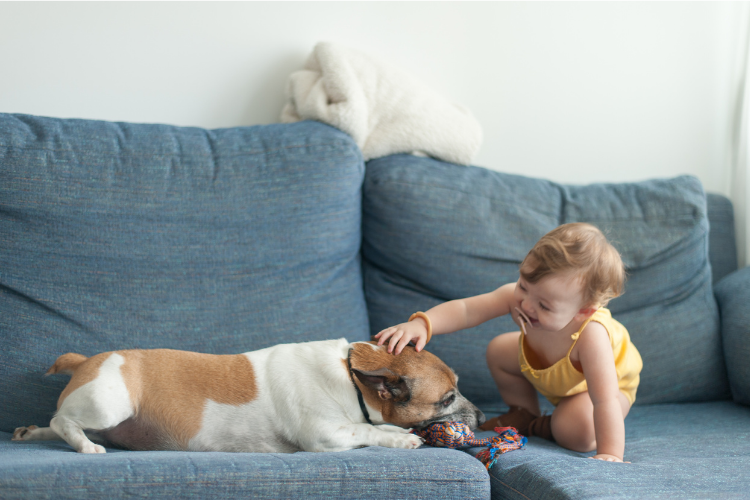We’ve all heard the expression, “The days are long but the years are short.” And that has never felt truer than when you realize your snuggly newborn has suddenly transformed into a toddler who’s holding your hand for a walk around the block. (Sniff, sniff.). Throughout the first year, your little one will go from one movement milestone to the next. Here’s what to expect, along with tips to foster curiosity and safe exploration of their exciting world.
Like any milestone, babies follow their own timetables. If you have any concerns about their development, talk to your pediatrician.

Now that your Tinybean is exploring, it may be time for a furry adventure buddy. See how Hill’s science-backed nutrition can give your best friend their best life.
Tummy time!
Is tummy time always a favorite activity? Nope. Most newborns prefer to be held, rather than doing this hard work. Tummy time helps build head, arm, and neck muscles that pave the way for more mobility. Seven weeks is a good time to try placing your baby on their tummy a couple times a day. They may only be able to keep their bobble head up for a few seconds, but they’ll build up to longer lengths of time. Don’t give up, even if you’re seeing some fussing. Distraction with a favorite toy in front helps shift their focus.
Let’s roll
All of that upper body strength building sets the scene for rolling, starting around four months. Going from front to back is more common than rolling from back to front at first, but rolling progression isn’t an exact science. One thing’s for sure: once they start, they won’t want to stop. Moving from one end of the living room to the other is fun for budding explorers. Keep a constant eye on your traveling baby and make sure childproofing is in place.
Sitting on top of the world
Anywhere from four months to eight months, you may see signs of your tot trying to sit. Good head control is important for sitting to be successful. You can support the gradual process by seating them upright on your lap often. When they’ve built up the strength to sit on their own, make sure it’s on a soft activity mat (not unattended on a couch or bed) and that you’re very close by to catch them should they topple back. This exciting new posture gives their favorite toys a whole new vantage point!
Cute crawling
Sitting unsupported (with the ability to independently move into and out of a seated position), rocking on all fours, and rolling are the major clues that crawling comes next. This movement milestone usually occurs between 7-10 months. Place their favorite toys just out of reach so they eagerly crawl to get to them. Some babies create their own unique “scoot” and work their way straight to walking (skipping crawling altogether!). It’s especially important that secure baby gates block the stairs.
Cruising (cool shades, optional)
The next step towards walking is pulling up, followed by cruising. Usually between 8-12 months, your busy baby will start using furniture and crib bars to stand tall and see their world. (Dressers, TV stands, and bookshelves should be securely mounted to the wall in case they want to use them as “props.”) They’ll also use furniture to support them as they shuffle around. The more opportunities you give babies to move (even if they’re unsteady and you’re in a constant state of panic—welcome to parenthood!), the better. You can walk with your baby, by holding onto both of their hands as they take little steps.
We’ve got a walker!
Alas, all that muscle strengthening, coordination, balance, and confidence building has led to walking. Many babies’ take their first steps around their first birthday (but it can happen earlier or later). It’ll start with a few wobbly steps and lots of wobbly falls. But the more practice, the more confidence and control. You’ll see your baby become able to walk in different directions, and even squat to pick something up and continue on their way! Indoors, your little one doesn’t need shoes. Walking around barefoot or in socks greatly supports healthy foot development. But if you’re heading outside on a walk, closed-toe, flexible shoes provide excellent support and protection.
How you can encourage exploration.
-
Boost resilience. Falls happen. Stay close by and provide reassurance after a fall that it’s okay and they can try again!
-
Add a new toy into the rotation. Push toys can help little ones work on standing and moving from place to place with some extra “help.”
-
Let them roam. You may be used to putting them in the stroller, swing, and activity center throughout the day. Try to minimize the use of those contraptions and give them lots of time to move about and work on their new skills.
-
Create new ways to explore. Who knew Tupperware and spatulas were so exciting? Put together a baby-safe (low) cabinet full of kitchen objects like plastic bowls and wooden spoons. Let them sort, stack, and bang.
-
Help them “help” you. While it’s not the most efficient way to get things done, opportunities to be helpful are wonderful for giving babies a sense of independence. Whether that’s sorting socks or cleaning up toys, little tasks go a long way.
-
Add a pet to the mix! Even though they’re little, babies and toddlers can learn from their parents how to care for and be kind to animals. They can help with getting supplies ready, joining you for walks, adding water to the dog bowl when it’s low and providing plenty of snuggles to your furry family member.
Considering adding a pet to your family? See how Hill’s science-backed nutrition can give your best friend their best life.
  |











